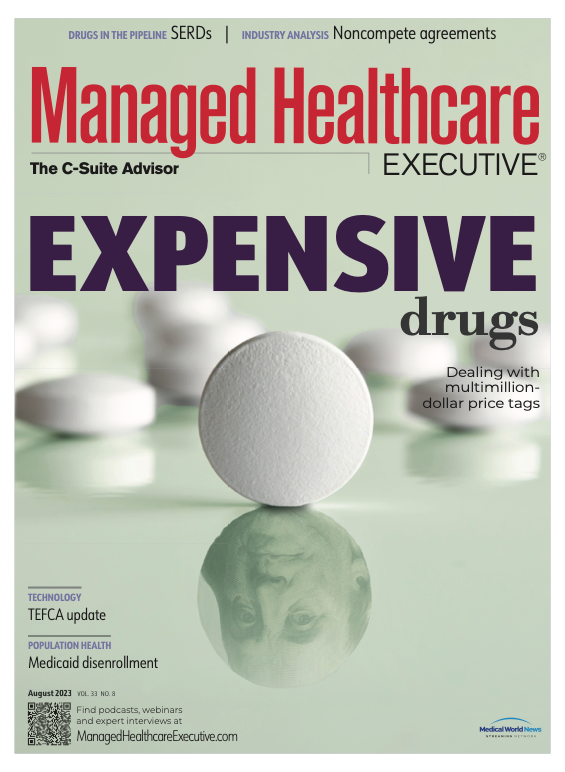Response Letters, Alzheimer’s Disease Drugs and Mounjaro
A discussion with Jeffrey Casberg, M.S., who joined the Managed Healthcare Executive editorial advisory board in July 2023. Casberg is senior vice president of clinical pharmacy at IPD Analytics and has played a leadership role in its drug management strategy business. A pharmacist by training, Casberg has had a long career in managed care.
This transcript has been edited for clarity and length.
Can you give us a short course on your career path and how you ended up at IPD Analytics?
I live in Connecticut. I’m a UConn grad — go Huskies — and I went to UConn School of Pharmacy and did some traditional roles early on in my career: retail, actually did a little pharmaceutical industry sales, home infusion. Then I went back and got a master’s in healthcare management. I’m trying to figure out what to do with my career, and I hear about something called managed care. This was in the early ’90s. I found a job in the newspaper with a company called WellPoint Pharmacy Management, which ended up turning into Anthem Pharmacy Management. From there, I went on to be the pharmacy director at a health plan in Connecticut called ConnectiCare for
16 years. About eight years ago, I was coming up on a bigger birthday, and I thought, where am I going to go in my life? Am I going to stay here and ride it out? Or am I going to try something new?
Casberg

I started to keep my ears open, and I came upon this company called IPD Analytics. The owner called and we discussed the company. It was really made up of intellectual property attorneys who track drug patents. They would write patent analysis for Wall Street clients and analyze how long a drug would be protected before generic competition and how many generics would come (on the market). The patent attorneys weren’t good at talking about medicine and drug management, so they wanted to bring on a pharmacist. I joined them as their first pharmacist. Now we have between 25 and
30 pharmacists.
Who are the clients?
Our clients are pretty much anybody who’s involved in pharmaceuticals. We have most of the PBMs (pharmacy benefit managers) in the country, health plans, pharmaceutical manufacturers — brand and generic — specialty manufacturers, wholesalers, retailers, hospital systems. All these people want to understand drug life cycles.
Do you have to have firewalls? I would think the sort of analytics you would deliver to the PBMs might have some information that pharma wouldn’t want you to share and vice versa. How do you manage the situation where you apparently have clients that can be adversaries?
I have a couple of hats here, andthen depending on who I’m speaking to, I put on a different hat. So when I’m speaking to the payers, you’re looking from the angle of drug management, appropriate drug utilization, spending the healthcare dollar most efficiently, prior authorization criteria, steps, quantity limits.
When we’re talking to the manufacturers I put on a different hat. From their angle, they’re looking at market access. What can we tell them to help them approach payers and hospitals and physicians to better sell their drug? How do we help them formulate their story to best access formularies?
With the drug pipeline, has anything surprised you lately as far as drugs that have been approved or maybe those that have been turned down?
There has been a significant increase in CRLs, or complete response letters. As a drug’s PDUFA (Prescription Drug User Fee Act) date is coming up, the FDA is looking at all different things, and what we found recently is that it is not usually clinical concerns — I guess there are some at times — but a lot of these CRLs are due to manufacturing facility delays. A lot of the drugs are manufactured overseas. The FDA goes to visit the manufacturing facilities, and they find a deficiency. It sometimes takes months — a year — to resolve these deficiencies.
Say you were to time travel three years ahead. What do you think is going stand out? What are the one or two drugs that were approved this year that are really going to make a difference?
So for the first half of the year, I guess you cannot not say Leqembi for Alzheimer’s from Eisai and Biogen; you have to mention that one. And then one coming just after it: donanemab from Eli Lilly. Without a doubt, Alzheimer’s approvals will impact the pharmaceutical industry in the future.
There’s a drug called Syfovre from Apellis Pharmaceuticals for geographic atrophy, which is part of dry AMD (age-related macular degeneration) for the eye. We have wet AMD and drugs for that: Eylea and others. But we’ve never had a dry AMD drug. I think that’s going to be impactful. There’s more of these patients out there than you think. The drug may not be a home run, but it’s a step in the right direction. Of course, it’s
not inexpensive.
There’s another drug called Veozah from Astellas Pharmaceuticals. It’s the first nonhormonal vasomotor symptom menopause drug. Estrogens have always been used for menopause. You don’t hear a lot about it (Veozah). But I think it’ll be impactful to a large group of patients in the country.
I guess they are not really drugs; they are vaccines. There’s a couple RSV (respiratory syncytial virus) vaccines. One from GSK called Arexvy was just approved. And then there’s another one on the way from Pfizer. I think they can have some impact.
You discussed Mounjaro at the Academy of Managed Care Pharmacy Annual Meeting in San Antonio this spring as perhaps being a huge drug in terms of sales. Could you fill us in on where things stand with Mounjaro and what your expectations are for that drug?
The statement I made was Mounjaro could be the first $100 billion drug. We’ll see.
Just to put that in perspective, Humira is the biggest drug of all time in terms of annual sales, at $25 billion to $30 billion.
Weight loss is kind of like the holy grail of pharmaceuticals. If you control your weight, you solve a lot of problems. It’s a huge market.
I just spoke to a subscriber of IPD in the past few weeks, and the subscriber mentioned that the GLP-1 category, which includes Ozempic, Trulicity and Victoza, is up about 75% year over year. You usually don’t see that, especially in a fairly mature category.
Payers are having to control drug spend in that category. It’s maybe 25% of payers who have some type of coverage for weight loss, and that coverage is more common among self-funded clients.
So the coverage is fairly slim at the moment. But payers are looking to add more controls as they look at their per-member, per-month costs rising. They trying to ensure the patient has type 2 diabetes and is not just taking a GLP-1 for weight loss. This will be a topic that keeps all of us discussing weight loss for years to come.
You see it as maybe being a $100 billion drug. But aren’t the payers going to prior authorize this to bits and add utilization review?
I’m not great at predicting the future. But I think slowly the doors will open up, and there will be more coverage. I think the political pressure will lead to more coverage.
Another avenue to get to the $100 billion is a diagnosis called NASH (nonalcoholic steatohepatitis), or fatty liver disease. Both Ozempic and Mounjaro are being studied in NASH.
So you have type 2 diabetes for these drugs. You have weight loss. You have NASH. I think that each one of those is a big therapeutic category. You add all three, and it’s a monster.

Conversations With Perry and Friends
April 14th 2025Perry Cohen, Pharm.D., a longtime member of the Managed Healthcare Executive editorial advisory board, is host of the Conversations with Perry and Friends podcast. His guest this episode is John Baackes, the former CEO of L.A. Care Health Plan.
Listen
Why Better Data and Awareness Matters for Medicaid Work Requirements
April 17th 2025With policymakers considering work requirements for Medicaid eligibility, Jennifer Haley, principal research associate in the Health Policy Division at the Urban Institute, said it’s more important than ever to understand how those changes could unintentionally cause harm, particularly when data systems fall short and public awareness is limited.
Read More
Breaking Down Health Plans, HSAs, AI With Paul Fronstin of EBRI
November 19th 2024Featured in this latest episode of Tuning In to the C-Suite podcast is Paul Fronstin, director of health benefits research at EBRI, who shed light on the evolving landscape of health benefits with editors of Managed Healthcare Executive.
Listen
Medicaid Expansion Linked To Timelier Lung Cancer Surgery and Access to High-Volume Hospitals
April 17th 2025New research shows that Medicaid expansion was linked to a 2.1% increase in timely lung cancer surgeries and a 2.8% rise in procedures at high-volume hospitals, highlighting how policy changes can impact cancer care access.
Read More